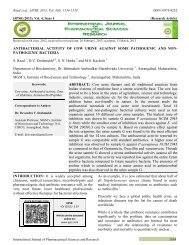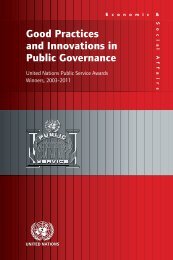fibonacci-numbers
fibonacci-numbers
fibonacci-numbers
You also want an ePaper? Increase the reach of your titles
YUMPU automatically turns print PDFs into web optimized ePapers that Google loves.
There are many other properties and identities related to Fibonacci <strong>numbers</strong> and people<br />
have written books about it. Due to the nature of this paper and a limited scope, it is hard to<br />
cover everything there is about for the Fibonacci <strong>numbers</strong>. For this reason, in this final section<br />
of the paper, I will introduce some real world applications related to Fibonacci <strong>numbers</strong> and<br />
their relationship with nature.<br />
Fibonacci <strong>numbers</strong> are important to perform a run‐time analysis of Euclid’s algorithm to<br />
find the greatest common divisor (GCD) of two integers. A pair of two consecutive Fibonacci<br />
<strong>numbers</strong> makes a worst case input for this algorithm (Knuth, Art of Computer Programming,<br />
Volume 1: Fundamental Algorithms, 1997). Fibonacci <strong>numbers</strong> have their application in the<br />
polyphase version of the Merge Sort algorithm. This algorithm divides an unsorted list in two<br />
lists such that the length of lists corresponds to two sequential Fibonacci <strong>numbers</strong>. The ratio of<br />
the lengths of the lists is an approximately same as (Knuth, Art of Computer Programming,<br />
Volume 1: Fundamental Algorithms, 1997). Fibonacci <strong>numbers</strong> are essential in the analysis of<br />
the Fibonacci heap data structures. A network topology for parallel computing uses a Fibonacci<br />
cube which is an undirected graph with Fibonacci number of nodes. The Fibonacci search<br />
technique is a one‐dimensional optimization method and is developed on the basis of Fibonacci<br />
<strong>numbers</strong> and their properties (Avriel & Wilde, 1966). IFF 8SVX audio file format in Amiga<br />
computers uses Fibonacci sequence to compand the original audio wave for optional lossy<br />
compression (Addison‐Wesley, 1991). The conversion factor from miles to kilometers<br />
1.609344 . When Fibonacci <strong>numbers</strong> are replaced by their successors, the sum of the<br />
decomposition of distance in miles into a sum of Fibonacci <strong>numbers</strong> is approximately same as<br />
kilometer sum. This can be achieved by shifting a radix 2 number register in golden ratio base<br />
Fibonacci <strong>numbers</strong> Page 7









